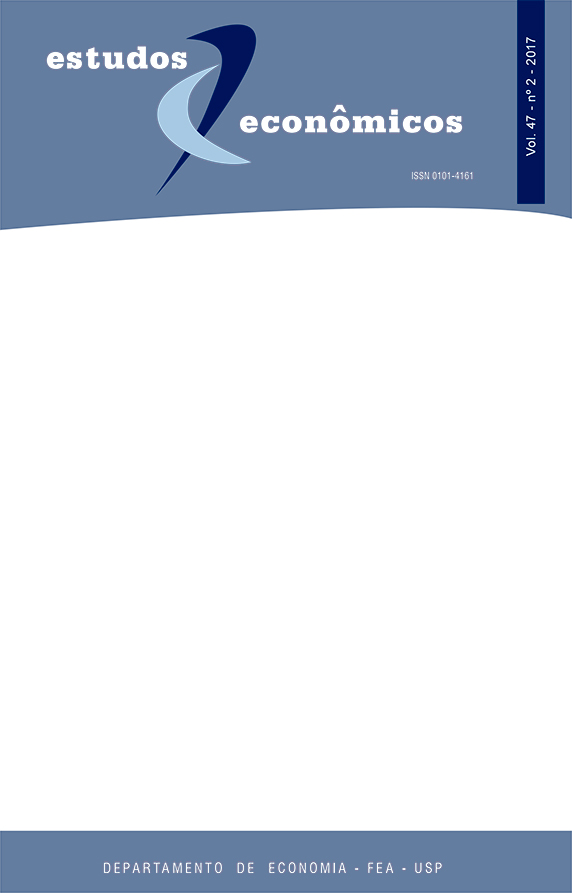O fluxo de capital para as economias emergentes e o grau de desenvolvimento do sistema financeiro
DOI:
https://doi.org/10.1590/0101-416147212kamPalavras-chave:
economias emergentes, fluxo de capital, parada súbita, desenvolvimento do sistema financeiro domésticoResumo
O presente artigo tem como objetivo analisar o papel do sistema financeiro doméstico como mitigador de eventos de paradas súbitas e condicionante de fluxos de capital de um grupo de 14 economias emergentes no período de 1999-2013 em especial em face de cenários externos desfavoráveis como aumento dos juros internacionais e aversão ao risco global. Os países analisados – Argentina, Brasil, Chile, Colômbia, Indonésia, Malásia, México, Peru, Filipinas, Rússia, África do Sul, Tailândia, Turquia e Ucrânia, representavam em agosto de 2014 aproximadamente 80% do índice EMBIPLUS e 60% do índice EMBIGLOBAL. Procurou-se distinguir o efeito sobre diversos tipos de fluxos de capital: Fluxo de entrada de Investimento Estrangeiro Direto, Fluxo de entrada de Investimento em Carteira e Fluxo Líquido, com análise de robustez para período desde 1990 e aumento do número de países emergentes. O resultado suporta evidências que o fortalecimento do sistema financeiro doméstico propicia aumento dos fluxos de entrada de capital diminuindo a probabilidade de ocorrência de parada súbita. Estimativas também destacam o papel dos fundamentos domésticos, tão importantes quanto os fatores globais nos condicionantes de fluxo de capital e na ocorrência paradas súbitas. Este fato motiva políticas públicas que incentivem o fortalecimento e desenvolvimento do sistema financeiro doméstico nos países emergentes, e ressalta o papel dos governos na captação de recursos externos.
Downloads
Referências
Alfaro, L.; Kalemli-Ozcan, S.; Volosovych, V. Capital Flows in a Globalized World: The Role of Policies and Institutions. NBER 11696, 2005.
Balance of Pay ments and International Investment Position Manual. International
Monetary Fund, 2013.
Disponível em http://www.imf.org/external/pubs/ft/bop/2007/pdf/bpm6.pdf
Bekaert, G.; Ehrmann, M.; Fratzscher, M.; Mehl, A. Global Crises and Equity Market Contagion. NBER Working Paper 17121, 2011.
BIS. “Capital flows and emerging market economies”. Committee on the Global Financial System. CGFS Papers No 33, 2009.
Broner, F.A.; Rigobon, R. Why are capital flows so much more volatile in emerging than in developing countries? 2004. Available at SSRN: http://ssrn.com/abstract=884381
Broto, C.; Díaz-Cassou, J.; Erce, A. Measuring and explaining the volatility of capital flows to emerging countries. Journal of Banking & Finance 35:1941-1953, 2011.
Calvo, G. “Capital flows and capital-markets crisis: the simple economics of sudden stops”. Journal of Applied Economics, p. 35-54, Nov. 1998.
Calvo, G., Leiderman, L., Reinhart, C. “Capital Inflows and Real Exchange Rate Appreciation in Latin America: The Role of External Factors”. IMF Staff Papers 40 (1), 1993.
Calvo, G., Leiderman, L., Reinhart, C. “Inflows of Capital to Developing Countries in the 1990s”. Journal of Economic Perspectives, American Economic Association, 10(2), pp: 123-139, 1996.
Calv o, G.A., Izquierdo A., Mejia, L. On the Empirics of Sudden Stops: the Relevance of Balance-Sheet Effects, NBER 10520, 2004.
Calv o, G.A., Izquierdo A., Mejia, L. Systemic Sudden Stops: The Relevance of Balance-Sheet Effects and Financial Integration. NBER 14026, 2008.
Chicago Board Options Exchange (2009). The CBOE VOLATILITY INDEX® - VIX®
Cowan , K.; De Gregorio, J.; Micco, A.; Neilson, C. “Financial diversification, sudden stops and sudden starts”. In: Current Account and External Financing, edited by Kevin Cowan, Sebastián Edwards, and Rodrigo O. Valdés, Santiago, Chile. © 2008. Central Bank of Chile.
Edwa rds, S. Financial openness, sudden stops and current account reversals. Washington: NBER, 2004. (Working Paper, n. 10.277).
Fa ucette, J.; Rothenberg, A; Warnock, F. Outflows–Induced Sudden Stops, The Journal of Policy Reform, 2005.Vol. 8, No. 2, 119–129.
Fernandez-Arias, E. The new wave of private capital inflows: Push or pull? Journal of Development Economics 48, pp: 389-418, 1996.
Fisher, R. A. “On the interpretation of χ2 from contingency tables, and the calculation of P”. Journal of the Royal Statistical Society 85 (1): 87–94, 1922.
Forbes K.; Warnock F. “Capital Flow Waves: surges, stops, flight and retrenchment”. NBER 17351, 2011.
Fratzscher, M. Capital Flows, Push versus Pull Factors and the Global Financial Crisis. Journal of International Economics 88. pp: 341-356, 2012.
Global Financial Stability Report. Financial Market Turbulence. Causes, Consequences, and Policies. “The Quality of Domestic Financial Markets and Capital Inflows” October 2007. International Monetary Fund.
Guidotti, P. E.; Sturzenegger, F.; Villar, A. On the consequences of sudden stops. Economia, Spring, 2004.
Institutional of International Finance. Capital Flows to Emerging Markets. May 2014.
Levine, R. Finance and Growth: Theory and Evidence. Handbook of Economic Growth, in: Philippe Aghion & Steven Durlauf (ed.), Handbook of Economic Growth, edition 1, volume 1, chapter 12, pp. 865–934, 2005.
Morgan, J.P. Emerging Markets Bond Index Plus (EMBI+) Rules and Methodology. J.P. Morgan Securities Inc. EmergingMarkets Research, 2004a.
Morgan, J.P. EMBI Global and EMBI Global Diversified. Rules and Methodology. J.P. Morgan Securities Inc. EmergingMarkets Research, 2004b.
Neumann, R., Penl, R., Tanku, A. Volatility of capital flows and financial liberalization: do specific flows respond differently? International Review of Economics & Finance 18(3). pp: 488-501, 2009.
Rocha, K.; Moreira, A. A Volatilidade dos Fluxos de Capital para Economias Emergentes: O Papel da Qualidade Institucional do Governo e do Sistema Financeiro Doméstico. Texto para Discussão IPEA 1893, 2013.
Sula, O. Surges and Sudden Stops of Capital Flows to Emerging Markets. Open Economies Review, volume 21 (4), pp. 589-605, 2010.
World Economic Outlook. Too Slow for Too Long. “Understanding the Slowdown in Capital Flows to Emerging Markets”. April 2016. International Monetary Fund.
Publicado
Edição
Seção
Licença
Copyright (c) 2017 Katia Rocha, Ajax Moreira, Marcos Silveira

Este trabalho está licenciado sob uma licença Creative Commons Attribution-NonCommercial 4.0 International License.
A submissão de artigo autoriza sua publicação e implica o compromisso de que o mesmo material não esteja sendo submetido a outro periódico.
A revista não paga direitos autorais aos autores dos artigos publicados.





 Atualizado em 14/08/2025
Atualizado em 14/08/2025